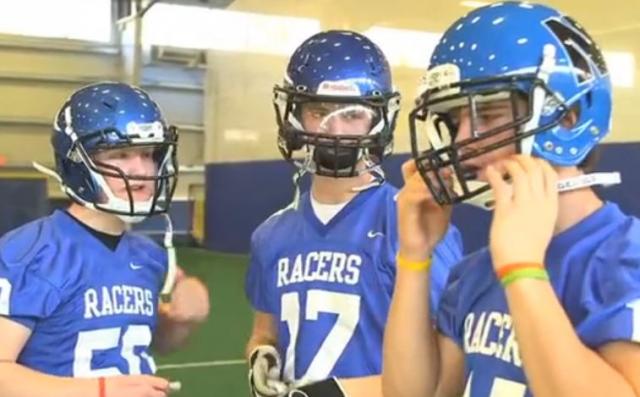The National Operating Committee on Standards for Athletic Equipment (NOCSAE) has decided, in order to "protect the integrity" of its helmet standards, that modification of helmets with third-party after-market add-ons will now be deemed as voiding its certification, which can only be regained if the helmet is retested with the add-on. 
The July 16, 2013 announcement, made with little fanfare and no advance warning to the public or interested parties, was greeted with predictable enthusiasm by helmet manufacturers (whose licensing fees fund NOCSAE), but is being heavily criticized, not just by the companies affected, particularly those in the emerging field of helmet impact sensors, but by football safety advocates and at least one national football organization, which see the ruling as a severe setback to their collective efforts to improve concussion safety through technological innovation.
Broad impact
By its plain language, the new NOCSAE rule covers any after-market item that "changes or alters the protective system [of a helmet] by adding or deleting protective padding to the inside or outside of the helmet, or which changes or alters the geometry of the shell or adds mass to the helmet, whether temporary or permanent."
It is thus broad enough, by its terms, to void the NOCSAE certification for helmets to which have a wide array of after-market products have been attached, including clear plastic face shields, decals, chin straps (including Battle Sports' Impact Indicator, and popular football chin straps from Nike and Under Armour), and colored pinnie scrimmage caps.
Its biggest impact, however, is likely to be on the manufacturers of two specific types of products: those making small, lightweight impact sensors designed to be attached to the inside or outside of a helmet, such as Shockbox, Brain Sentry, Safe Brain, and gForce Tracker sensors; and supplemental helmet protective padding products, including Shockstrip, Guardian Cap, and Unequal Technologies' Gyro and Maxx. [Update: On August 7, 2013, Unequal announced via PR Newswire that it had obtained a "clarification" from NOCSAE that, according to Unequal, "because Unequal supplemental head padding in a helmet is not intended to, and does not, permanently attach to the helmet, the use of Unequal product will not void a helmet's certification."]
In just the first two weeks after the ruling was issued, it already appears to be having a profound impact on the manufacturers of after-market products, with some reporting mass cancellations of orders which could drive some out of business. [Update: for the effect the NOCSAE ruling is having on Guardian Cap, and the "Catch-22" the company has found itself in as a result, click here]
It is also likely to have a profound, and some critics say, extremely negative effect on football player safety. While NOCSAE consistently points out that adherence by football helmet manufacturers to its standard - first issued in 1973 and still designed to certify only that the helmet can withstand the high impact forces necessary to fracture a player's skull - is ostensibly voluntary, it is followed by governing bodies at every level of football. NOCSAE's action to void certification for helmets equipped with third-party add-ons and require retesting and recertification is thus likely to make schools and youth football programs extremely reluctant, if not entirely unwilling or legally unable, to allow such add-ons out of liability concerns, with the action coming at the worst possible time, just as programs are gearing up for the 2012 football season.
"Real step backwards"
While a spokesperson for USA Football said the organization does not sanction helmets, and expressed support for the NOCSAE statement, Jon Butler, Executive Director of Pop Warner, however, expressed disappointment at the NOCSAE ruling, at least with respect to the use of helmet impact sensors. "I hope that NOCSAE will reverse their ruling as it is a real step backwards. We have been doing [beta] testing [of impact sensor-equipped helmets], as have many others, and this needs to continue. How can we do testing without kids wearing the [sensor-equipped] helmets?" Butler wondered.
The National Federation of State High School Associations (NFHS), the national governing body for high school football, issued a statement in August 2012 from its Rules Committee saying that, absent a clear answer on the question of the net impact of exterior helmet padding on its protective ability, the decision about their use would remain within the discretion of high school teams, coaches, athletes, and parents. The statement specifically mentioned supplemental helmet padding manufactured by Pro Cap (no longer in business), Guardian Cap, and Shockstrip, and did not cover helmet sensors.
Despite repeated requests, NFHS has thus far refused to comment.
It should be noted, however, that Article 1, Rule 1‐5.1.a. of NFHS's rule entitled "Mandatory equipment" which, in pertinent part, requires that a player participate wear a properly fitted helmet "which shall be professionally manufactured and not altered to decrease protection, ... which met the NOCSAE test standard at the time of manufacture." (emphasis supplied). A strict reading of that language would appear to allow a helmet to which a third-party, after-market product has been affixed so long as the alteration does not decrease protection so long as the helmet met the NOCSAE test standard at the time it left the manufacture.








